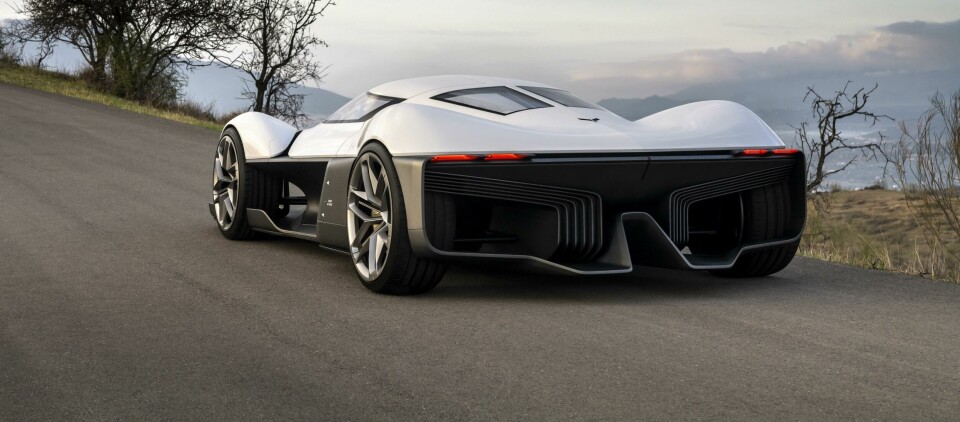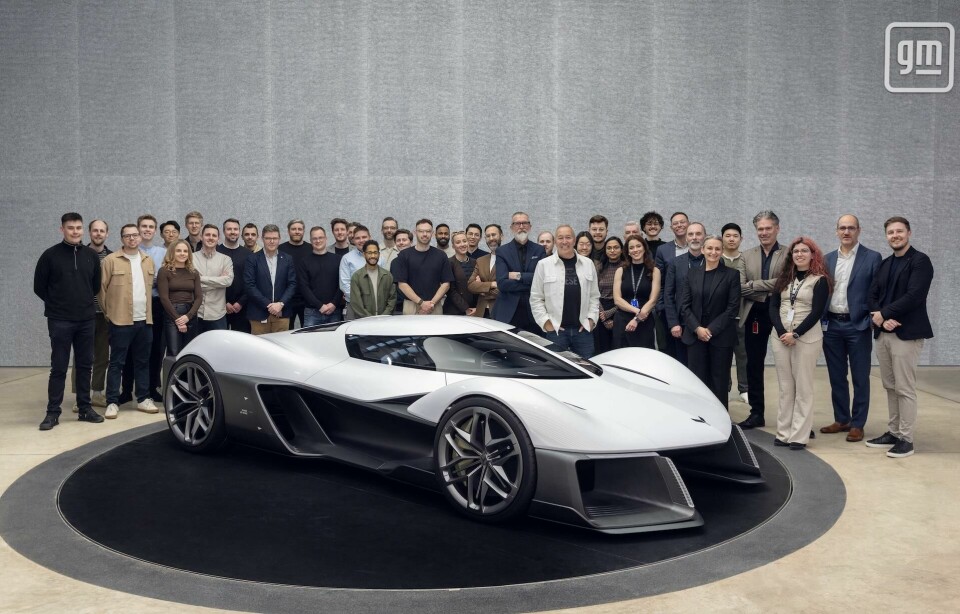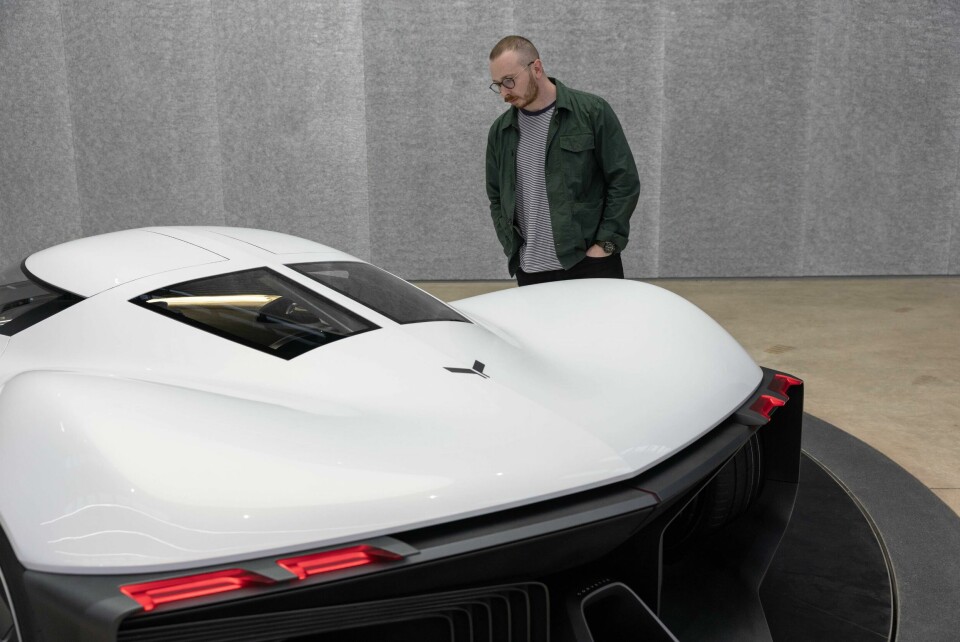
GM’s UK studio reveals first major project: an electric Corvette concept
With an all-star team led by Julian Thomson, the Midlands-based design studio has lifted the covers on a blistering new concept
Nestled in a quiet industrial estate in Leamington Spa, GM’s UK advanced design studio could have played it safe with its first project destined for public eyes. But not so: why not rethink an American icon in the Corvette.
On a tour of the facility earlier last year, CDN learned how this unassuming outpost would be a source of creativity for the main GM “mothership”, funnelling new ideas and offering a different perspective to the global design footprint. And a fresh perspective is exactly what was given – who would have thought a UK design studio would get its hands on the Corvette brand.

Speaking to design director and studio lead Julian Thomson, he agrees that it is unexpected and might even raise a few eyebrows, particularly those across the pond.
But because the team is less embedded in American culture more generally, and with no lingering biases about what a Corvette should be, Thomson believes the team was naturally more meticulous in its research. “Let’s say you were working on a new Chevrolet truck, and you’ve designed the last three. You’ll probably have a very fixed idea about what it should be,” Thomson told CDN. “Here, we’re able to step back and look at things with fresh eyes.”
A video produced by the team details how they explored different influences, past and future trends and even potential brand collaborations. They dug into the rich heritage of the Corvette and what it stands for. What could be built on and elevated. And importantly, how to respect its heritage while doing so. “We were not asked to imagine a Corvette for Leamington Spa,” Thomson jokes during the tour.
Brand strategy specialist Sophie Ellis highlighted how the team had even considered broader ‘lifestyle’ considerations for the Corvette and created a wearable key – a ring – which would share information on state of charge and, importantly, the vehicle’s location: “It’s so low to the ground, you might not be able to find it,” joked Ellis. The ring itself is in fact an extrusion of the V-shaped Corvette logo, which we thought was a nice touch. The overall theme was led by senior designer Oliver Cattell-Ford, and we noticed some nice renders and sketches produced by People Awards finallist and ex-Coventry student Zicheng ‘Seaton’ Cui, too.
Indeed, the concept is exceptionally low to the ground and incredibly wide both in terms of track and tyre size; we spied 315mm treads on show. The overall package feels a little more track-focussed than a standard road-going Corvette – about level with a ZR1 perhaps – with gaping intakes and active aero wherever possible. Open tunnels run through the length of the car, meaning air is unimpeded and flows straight through. The front suspension assembly is also on show, with curious horizontal stuts that run parallel with the shoulder line.
At the rear, the taillamps sit atop a vast, gaping diffuser that from a distance looks like a sperm whale opening its mouth. Pictures do not quite do this justice. It is cavernous.
Clear nods to the original can be seen in the T-top split roof
Look closer, and a series of fluted wings flow in-to-out, covering the top portion of the rear tyres but leaving most of the rubber in plain sight. Perhaps the most distinctive element is the absence of the A-pillars, creating a sweeping panoramic windshield; the promotional video uses the iconic Laguna Seca track, and we get the impression that IndyCar racers served as inspiration for this. The picture below showcases many of the concept’s defining elements.

As alluded to earlier in the feature, the team was careful to not be too outlandish. This should be a Corvette afterall. Clear nods to the Stingray can be seen in the T-Top split roof, characterised by an architectural central spine that runs from the cowl through to the rear window; this naturally led the team to choose butterfly doors.
The tail lamps feel familiar, not round like the Stingray and more of a natural evolution from the latest C8. The wheel arches sit proudly front and rear too, as expected from any Corvette, and we got a good sense of how these features were created thanks to some help from exterior designer Hitesh Panchal and head of exterior design Dominic Najafi, who both assisted CDN with a spot of scraping and taping on a scale model. A new career in clay does not beckon.
Inside, that unrestricted view creates a surprisingly bright cabin for a vehicle of this ilk. A rectangular steering wheel offers a flat bottom for spirit driving but also soft-touch material and rounded corners for comfort.
The steering column behind pushes out from the IP and in its polished metal finish chimes nicely with other details throughout the cabin. The seats are somehow contemporary yet retro, bringing a distinct ‘space race’ feel that is in line with American design of the 60s and 70s. A series of illuminated lines – horizontal fluting – wraps around the entire cabin, from the top of the door cards, across the IP and back round to the rear.
The concept was created using a mix of digital and physical tools, both championed in their own way by different members of the design team during our preview. But it is hard to look past the set up of the UK studio, which champions a series of multi-axis clay milling machines at the centre.
It is a strong first showing for the studio… there is plenty more on the way
As Thomson and others explained, refining through clay is very much integral to the process and various team members – not just modellers – have their say. “During an internal review you will get the clay modeller, the digital modeller and other designers all looking at the same part of the car, but they all have a different interpretation of how to fix something,” Thomson notes. “We like using all of the different disciplines together like that.”
For Thomson, the move to GM has also seen him a little more hands on than at other points in his career as a design leader.
“What’s different for me this time is that because the design organisation is so big and I’m a small part of an organisation, I just work on design,” he explained, “I’m not touching finance, marketing, and everything else. Most of my time is spent talking with designers and I feel very comfortable doing that, and it is a very open and receptive organisation when it comes to sharing ideas. At this stage of my career, I really like that. It’s refreshing.”
It is a strong first showing for the studio and as we learned there is plenty more on the way, not just with Chevrolet but other brands under the GM umbrella. While we are not at liberty to discuss what was shown, that too is a brand with some exciting things in the works. Watch this space. Thomson is clearly keen to get stuck in, and suggested that models like the Buick Riviera, Chevrolet Blazer and Cadillac Escalade are projects he would like to get his hands on.
“I worked on Range Rover [earlier in my career] but I wouldn’t want to do an Escalade like a Range Rover. I want to do an Escalade like an Escalade,” he muses. “The impact that luxury SUVs have had on [American] culture is fascinating. Taking that on would be a real challenge.”







































